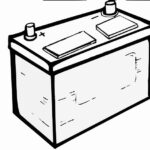Maintaining your car’s pristine condition is about more than just aesthetics; it’s about preserving its value and preventing further damage like rust. Dents and dings, unfortunately, are a common part of car ownership. Whether it’s a minor door ding or a more noticeable dent, addressing these issues promptly is crucial.
While significant damage may necessitate professional intervention, many car door dents, especially smaller ones, can be effectively repaired at home. This guide will walk you through various methods to fix a dent in your car door, from simple DIY techniques to when it’s best to seek professional help. Understanding your options and the steps involved will empower you to restore your car door’s smooth finish.
Car dents can arise from a multitude of everyday situations. Even careful drivers aren’t immune to the occasional mishap.
Minor dents are often the result of:
- Hailstorms: Falling hail can leave small, scattered dents across your car’s surface, including the doors.
- Road Debris: Small stones or objects kicked up from the road can impact your car door, causing minor dents.
- Stray Shopping Carts: Uncontrolled shopping carts in parking lots are notorious for causing dings and dents.
Door dings, specifically, are frequently caused by:
- Opening Doors Too Wide: Accidentally hitting another car, a wall, or a post when opening your car door.
- Other Vehicles: Another car door striking yours in a parking space.
Larger, more significant car door dents are often the result of:
- Car Accidents: Collisions, even minor ones, can lead to dents of varying sizes.
- Falling Objects: Tree branches or other heavy objects falling onto your car door.
It’s important to distinguish between different types of dents, as this can influence the repair method. While “dent” and “ding” are sometimes used interchangeably for minor damage, understanding the nuances helps in choosing the right approach. Here’s a breakdown of common dent types:
| Type | Description | Removal Complexity |
|---|---|---|
| Ding | Small, shallow damage | Simple DIY |
| Round Dent | Circular indentation | Often DIY “pop-out” |
| Sharp Dent | Small, deep, concentrated damage | More Challenging DIY |
| Crease Dent | Elongated dent, often with paint damage | Professional Recommended |
| Serious Dents | Large, multiple dents, potential structural damage | Professional Required |
Addressing car door dents promptly is advisable for several reasons, extending beyond mere aesthetics. While DIY dent repair can be budget-friendly, typically under $100, professional repairs can range from hundreds to thousands of dollars depending on the severity and method.
Delaying dent repair can lead to:
- Rust and Corrosion: If the dent has chipped or cracked the paint, it exposes the underlying metal to moisture, leading to rust formation and paint flaking.
- Structural Issues: Larger dents, particularly crease dents from significant impacts, might conceal underlying structural damage to the car door, compromising safety.
- Reduced Fuel Efficiency: While seemingly minor, multiple or larger dents can subtly affect aerodynamics, potentially leading to a decrease in fuel economy.
Therefore, timely dent repair is not just about maintaining your car’s appearance but also about preventing further damage and potential safety concerns. Fortunately, numerous options are available for effective dent removal.
For minor dents, door dings, or bumper damage on your car door, DIY repair can be a cost-effective and straightforward solution.
Here’s a guide to common DIY methods:
Repairing Plastic Car Door Dents (Bumpers & Some Door Panels)
Many modern car doors and bumpers incorporate plastic components. Plastic dents often respond well to heat-based DIY methods.
-
Heat the Dent: Use a hairdryer on a medium to high setting to gently heat the dented plastic area. Keep the hairdryer moving and maintain a distance of a few inches to avoid overheating and damaging the plastic. Heat until the plastic is warm to the touch but not excessively hot.
-
Apply Cool Compressed Air (for Small Dents): For smaller dents, quickly switch to a can of compressed air held upside down to spray cool air onto the heated area. The rapid temperature change can cause the plastic to contract and pop back into its original shape.
-
Utilize a Dent Puller (for Larger or Stubborn Dents): If compressed air alone isn’t sufficient, or for larger dents, a suction cup dent puller can be very effective. These are readily available and inexpensive. Attach the suction cup firmly to the center of the dent and apply steady, firm pressure to pull the dent outwards.
-
Smooth Out Minor Imperfections: Occasionally, pulling out a dent may create small, new bumps or imperfections. Gently smooth these out with your hands or the flat end of the dent puller.
Repairing Metal Car Door Dents
For metal car door panels, a dent repair kit designed for metal is typically required. These kits usually include various tools to pull and manipulate the metal back into shape.
-
Heat the Dent (Optional for Small Dents): For larger or more resistant metal dents, preheating the area with a hairdryer can make the metal more pliable. For very small, shallow dents, this step may be skipped.
-
Suction the Dent Outward: Use a suction cup dent puller to attempt to pull the dent outwards. The goal here isn’t necessarily to completely remove the dent in this step but to reduce its depth and size.
-
Clean the Metal Surface: Wipe the area around the dent with a microfiber towel to remove any dirt or debris. This ensures proper adhesion for the next steps.
-
Prepare the Bridge Puller: Dent repair kits often include a “bridge puller.” This tool utilizes adhesive heads that are glued to the dent. Apply the specialized glue from the kit to a puller head and firmly attach it to the deepest point of the dent.
-
Attach Bridge Puller Head and Allow Glue to Cure: Press and hold the puller head firmly against the glued area and allow the adhesive to cure completely according to the kit’s instructions (usually 4-8 minutes).
-
Use the Bridge Puller to Remove the Dent: Once the glue is cured, attach the bridge puller tool to the adhered head. Slowly turn the dial on the bridge puller, applying controlled pressure to pull the dent outwards. Stop when the dent is removed and the metal is flush with the surrounding panel. Avoid over-pulling.
-
Detach Head and Puller: Remove the bridge puller tool. Use a hairdryer to gently heat the glue on the puller head. This softens the adhesive, allowing you to carefully detach the head from the car door. Clean any remaining glue residue with a microfiber cloth.
-
Paint Touch-Up (If Necessary): If the dent repair has resulted in any paint damage (scratches or chips), use a car paint touch-up kit that matches your car’s color code. Clean the area, apply primer if included in the kit, and then carefully apply thin coats of touch-up paint until the damage is concealed.
Utilizing Body Filler for Deeper or More Complex Dents
For dents that are deeper, more complex in shape, or not fully removable with pulling techniques, body filler (like Bondo®) can be used to create a smooth, even surface before painting.
-
Clean the Dented Area: Thoroughly clean the dent and surrounding area with soap and water. Dry completely with a microfiber cloth.
-
Sand the Paint: Use 80-grit sandpaper to carefully sand away the paint within the dent and extending 2-5 inches around it. This provides a rough surface for the body filler to adhere to.
-
Minimize the Dent (Optional): If possible, use dent removal techniques (pulling) to reduce the depth of the dent before applying filler. This minimizes the amount of filler needed.
-
Apply Body Filler: Following the body filler product instructions, mix a small batch. Apply the filler firmly into the dent, using a plastic spreader. Apply enough filler to slightly overfill the dent, creating a raised area that is flush with the surrounding car door panel. Allow the filler to dry completely (typically 15-20 minutes).
-
Initial Sanding: Once dry, use 80-grit sandpaper to begin shaping the filler. Sand down the high spots, gradually shaping the filler to match the contours of the surrounding car door panel. If low spots remain, repeat steps 4 and 5 with additional thin layers of filler until the surface is level.
-
Smooth Sanding: Switch to 180-grit sandpaper to refine the shape and smooth the body filler surface.
-
Apply Glaze and Spot Putty: Apply a thin layer of glazing and spot putty over the entire filled area and slightly beyond. This fills in any minor imperfections and pinholes in the body filler.
-
Final Sanding: After the glaze dries, sand with 180-grit sandpaper to level it. Finish with 320-grit sandpaper to remove any fine scratches and create a smooth surface ready for priming and painting.
-
Prime and Paint: Use a car paint repair kit, including primer and matching paint, to prime and paint the repaired area. Apply primer, followed by thin, even coats of color paint, blending into the surrounding original paint for a seamless finish.
While DIY methods can be effective for many car door dents, there are situations where professional repair is the best or only option. For achieving a factory-finish repair, or for more complex damage, consider professional services.
Professional Car Door Dent Repair Options
-
Paintless Dent Repair (PDR): PDR is a specialized technique for removing dents without damaging the paint. PDR technicians use specialized tools to gently massage and manipulate the metal from behind the panel, effectively “pushing” the dent out. PDR is ideal for:
- Dents without paint damage.
- Minor to moderate dents.
- Dents in easily accessible areas of the car door.
- PDR offers a faster and often more affordable professional repair option compared to traditional body shop work. Technicians may even offer mobile services, coming to your location.
-
Auto Body Shops: For more significant car door damage, including:
- Large or deep dents.
- Crease dents.
- Dents with paint damage requiring repainting.
- Dents in difficult-to-access areas.
- Auto body shops provide comprehensive dent repair services. They have the expertise and equipment to handle complex repairs, including metalwork, body filler application, and professional color-matched painting.
The cost to fix a dent in your car door can vary widely depending on the repair method, dent size and location, and whether you choose DIY or professional services.
-
DIY Dent Repair: DIY dent repair kits typically range from $40 to $99. Individual supplies like dent pullers or body filler can be purchased separately for around $20 or less each. DIY is the most cost-effective option for minor dents.
-
Paintless Dent Repair (PDR): PDR costs are influenced by dent size and complexity:
- Small, light dents: $50 – $100
- Medium dents: $75 – $300
- Large dents: $300 – $500
-
Auto Body Shop Repair: Body shop repairs are the most expensive option, especially for larger dents or those requiring repainting. Costs can easily reach $2,000 or more, particularly for extensive damage or if panel replacement is considered. For repairs exceeding $1,000, it’s worth discussing with the body shop if replacing the entire door panel might be a more cost-effective solution in some cases.
Fixing a dent in your car door is an important aspect of vehicle maintenance, both for preserving its appearance and preventing further issues. Whether you choose to tackle minor dents yourself with DIY methods or opt for the expertise of professional services like PDR or auto body shops for more significant damage, addressing dents promptly is beneficial. By understanding the different repair techniques and cost considerations, you can make an informed decision to restore your car door and maintain your vehicle’s overall condition. If you’re unsure about the best approach for your car door dent, seeking a professional assessment from a PDR technician or auto body shop is always a wise first step.

